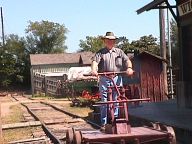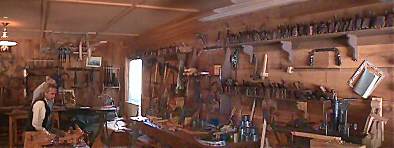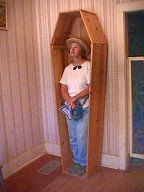The Old Cowtown Museum
A Living Museum
Wichita, KS
September 9th, 2004
Having  arrived in Wichita, we found that that there were all
kinds of interesting thing to see and do. After a discussion as to which
one we wanted to see, we decided on a leisurely stroll through the old
west. Where better to do this than in a cowtown, the Cowtown Museum
that is. We arrived on one of those unfortunate days when things had not
gone well for the old re-constructed turn of the century town. A water
main break had turned part of the main street into a mud hole, but the real
problem was that the water had been turned off in he park, including the
bathrooms. This not only left most of the park free of tourists, we got in
on a reduced price, so it was a
arrived in Wichita, we found that that there were all
kinds of interesting thing to see and do. After a discussion as to which
one we wanted to see, we decided on a leisurely stroll through the old
west. Where better to do this than in a cowtown, the Cowtown Museum
that is. We arrived on one of those unfortunate days when things had not
gone well for the old re-constructed turn of the century town. A water
main break had turned part of the main street into a mud hole, but the real
problem was that the water had been turned off in he park, including the
bathrooms. This not only left most of the park free of tourists, we got in
on a reduced price, so it was a  good day for us.
Not many of the docents
arrived but those that did were free to talk to us about the things that they
were doing and about the town of Wichita. In setting the historic scene it
was necessary to find out just how the town got its beginning. In 1868, D.S.
Munger, of the Wichita Land and Town Company, made the first land claims in the
area that became Wichita. Munger, lie many other settlers, filed those
claims at time when the land still legally belonged to the Osage Indian nation
as trust lands. This meant land had to be purchased outright, and could
good day for us.
Not many of the docents
arrived but those that did were free to talk to us about the things that they
were doing and about the town of Wichita. In setting the historic scene it
was necessary to find out just how the town got its beginning. In 1868, D.S.
Munger, of the Wichita Land and Town Company, made the first land claims in the
area that became Wichita. Munger, lie many other settlers, filed those
claims at time when the land still legally belonged to the Osage Indian nation
as trust lands. This meant land had to be purchased outright, and could not be settled under the popular Homestead Act of 1862. This act granted
ownership to land after it had been improved and occupied for 5 years. The
first non-Indian settlers came with the hope Congress, through treaty
negotiations with the Osage, would make the land available for legal settlement.
Congress approved the terms of the negotiations in 1870, opening the land for
purchase through the U.S. Land office at the price of $1.25 per acre. many
settlers were unable to buy the land they desired because speculators
not be settled under the popular Homestead Act of 1862. This act granted
ownership to land after it had been improved and occupied for 5 years. The
first non-Indian settlers came with the hope Congress, through treaty
negotiations with the Osage, would make the land available for legal settlement.
Congress approved the terms of the negotiations in 1870, opening the land for
purchase through the U.S. Land office at the price of $1.25 per acre. many
settlers were unable to buy the land they desired because speculators  had
purchased large sections for resale at inflated prices. Private agents
then sold the land working out of offices much like this one. During the
1870s, the acquisition of land by speculators, the development of the railroad
and he growth of farming in the country led to the price of land rising as high
as $4.00 an acre. Our first stop along the wooden boardwalk was probable
most prominent building in town. The town's general store. General stores
were significant in both rural and urban communities. In rural areas a
general store provided customers with all of their basic needs. In towns
such as Wichita, they provided basic grocery and household items and services
had
purchased large sections for resale at inflated prices. Private agents
then sold the land working out of offices much like this one. During the
1870s, the acquisition of land by speculators, the development of the railroad
and he growth of farming in the country led to the price of land rising as high
as $4.00 an acre. Our first stop along the wooden boardwalk was probable
most prominent building in town. The town's general store. General stores
were significant in both rural and urban communities. In rural areas a
general store provided customers with all of their basic needs. In towns
such as Wichita, they provided basic grocery and household items and services  during
the year before improved transportation allowed merchants to specialize their
inventories. Around the corner and down the side street, we found the
train tacks, next to the granary. After the arrival of the train, Wichita began
to boom. For some time it was the cattle transfer center between the
ranches of Kansas and Chicago. I had to try my hand on what else, a hand
cart. I can't believe people used those things for transportation.
It is really quite a bit of work to move them. Further on down the street we
stopped by the local work working shop. Here we met a marvelous character
in the person of Peter Mader.
during
the year before improved transportation allowed merchants to specialize their
inventories. Around the corner and down the side street, we found the
train tacks, next to the granary. After the arrival of the train, Wichita began
to boom. For some time it was the cattle transfer center between the
ranches of Kansas and Chicago. I had to try my hand on what else, a hand
cart. I can't believe people used those things for transportation.
It is really quite a bit of work to move them. Further on down the street we
stopped by the local work working shop. Here we met a marvelous character
in the person of Peter Mader.  A
master of the old time machines that were essential from 1860 to 1900. We
watched as he moved from one to another demonstrating each with a couple of
swipes of wood, or a shave or two depending on what the job was. The room
itself was a masterpiece of antique hand tools. Hundreds of them were
sitting on shelves all around the room. There were many other businesses that we
visited along the walkways of the various streets that made up the town.
The last one we reviewed caused Laura to get "into" the act of a
docent. The local mortuary offered a wooden coffin, one size fits
all. Here we learned that Victorian
society's morning customs softened and veiled the harsh realities of
death. New, mass produced rectangular caskets replaced traditional
body-shaped coffins, The term "cemetery" replaced
"graveyard" as the preferred term for a loved one's final resting
place. Religious symbolism and imagery dominated cemetery marks and
eulogies. Terms such as "At Rest" and "Only Sleeping"
were common on markers and represented an increasingly romanticized view of
death. With this as a fitting "end' to our experiences in Cowtown, we put
our day "to rest" and rode off into the sunset. All in all, it
was a good day, and Cowtown is a very good place to visit in Wichita.
A
master of the old time machines that were essential from 1860 to 1900. We
watched as he moved from one to another demonstrating each with a couple of
swipes of wood, or a shave or two depending on what the job was. The room
itself was a masterpiece of antique hand tools. Hundreds of them were
sitting on shelves all around the room. There were many other businesses that we
visited along the walkways of the various streets that made up the town.
The last one we reviewed caused Laura to get "into" the act of a
docent. The local mortuary offered a wooden coffin, one size fits
all. Here we learned that Victorian
society's morning customs softened and veiled the harsh realities of
death. New, mass produced rectangular caskets replaced traditional
body-shaped coffins, The term "cemetery" replaced
"graveyard" as the preferred term for a loved one's final resting
place. Religious symbolism and imagery dominated cemetery marks and
eulogies. Terms such as "At Rest" and "Only Sleeping"
were common on markers and represented an increasingly romanticized view of
death. With this as a fitting "end' to our experiences in Cowtown, we put
our day "to rest" and rode off into the sunset. All in all, it
was a good day, and Cowtown is a very good place to visit in Wichita.
*** THE END ***
